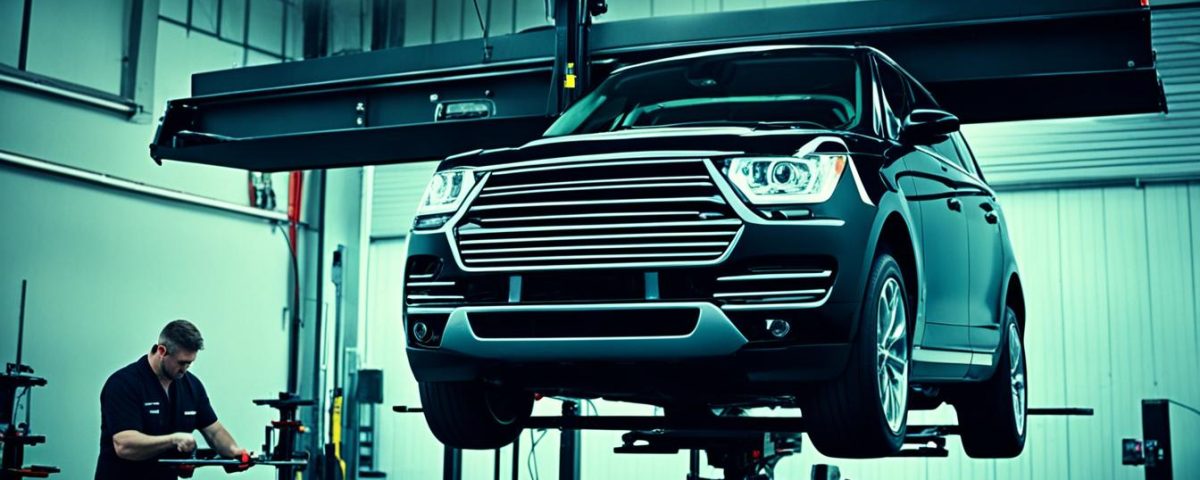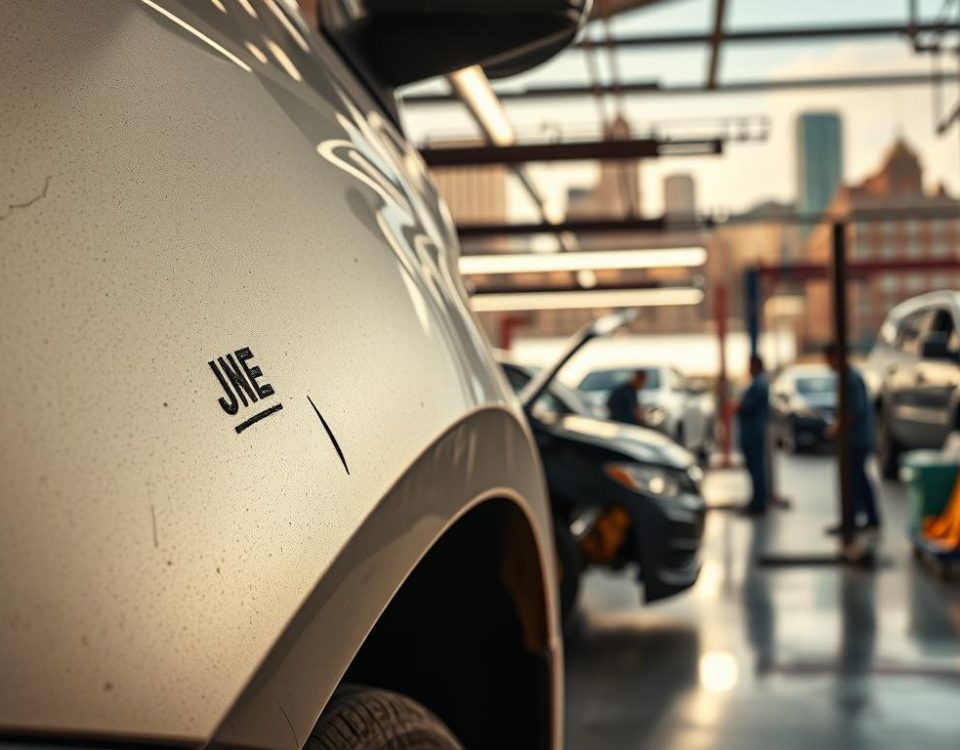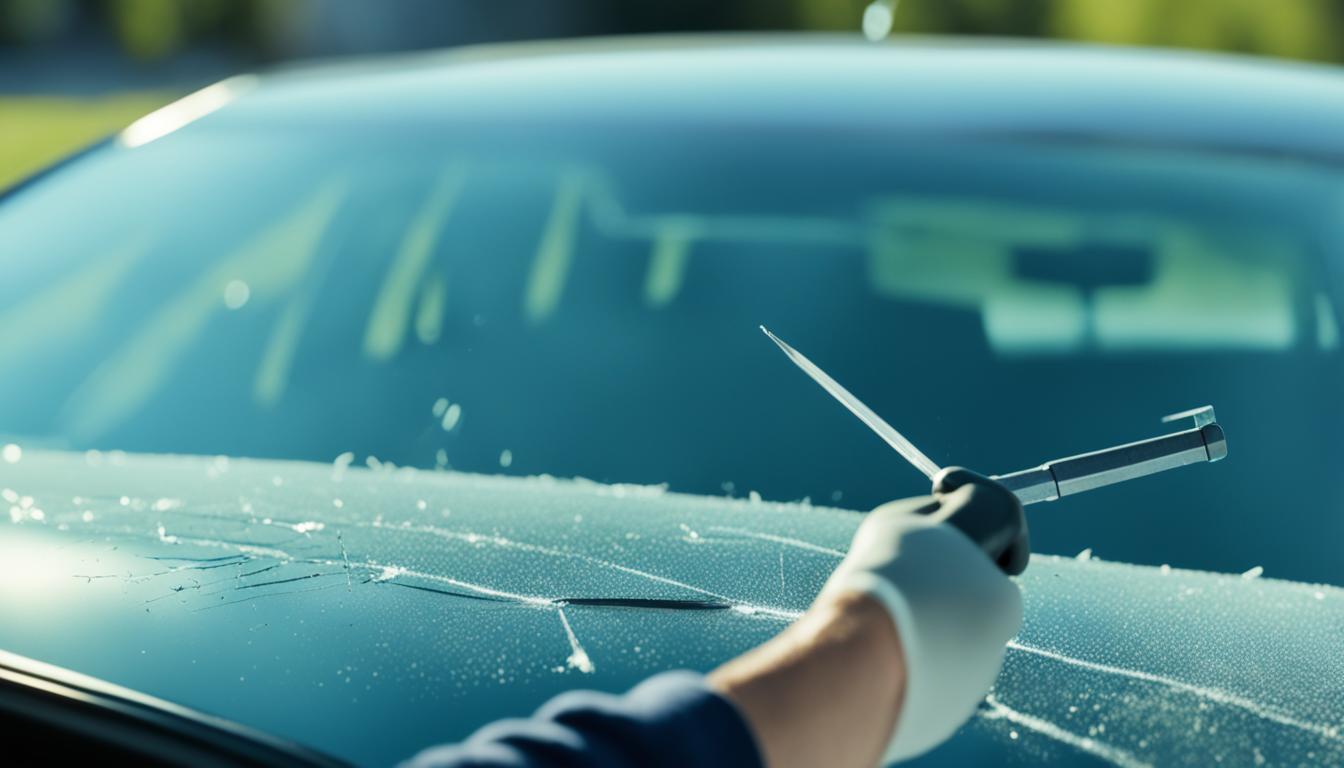
The Essentials of Windshield Repair and Replacement
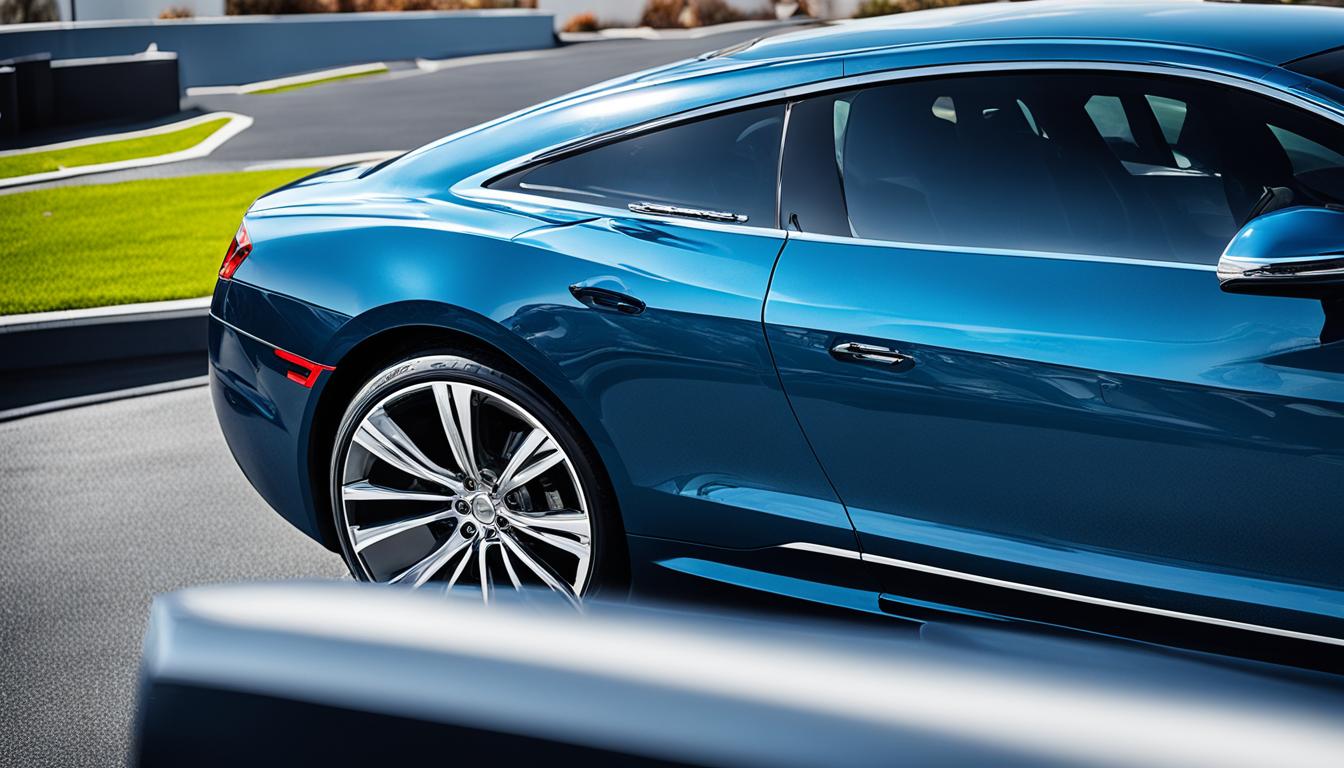
Comprehensive Vehicle Detailing Services After Collision Repair
When our vehicles collide, the impact can often lead to misaligned wheels, a critical issue that should not be overlooked. Proper wheel alignment is essential for maintaining the safety, performance, and efficiency of our cars after a collision. In this article, we’ll explore why getting your wheels realigned is a crucial step in the collision repair process.
Key Takeaways
- Wheel alignment is vital for ensuring your vehicle’s safety and handling after a collision.
- Properly aligned wheels can improve fuel efficiency and extend the life of your tires.
- Regular wheel alignment checks can help prevent future accidents and costly repairs.
- Identifying and addressing alignment issues promptly is essential for the well-being of your vehicle.
- Entrusting your car’s alignment to a professional service provider is the best way to ensure it’s done correctly.
Wheel Alignment after a Crash
After a collision, addressing post-accident alignment should be one of the top priorities. Proper wheel alignment is crucial to ensure your vehicle is driving smoothly and the suspension repair is functioning correctly. The sooner you address this issue, the better. If you’re not comfortable performing the alignment yourself, it’s best to take your car to a professional for a thorough vehicle diagnostics assessment.
The mechanic may need to make adjustments to various components, such as the suspension, brakes, and tires, to restore your car’s proper alignment and get it rolling correctly again. This comprehensive approach will help you regain control and confidence behind the wheel, enhancing both safety and performance.
- Identify any abnormal noises or responses from your vehicle during driving.
- Slowly drive your car to the nearest alignment shop for a professional assessment.
- Request the alignment shop to conduct a quick alignment check as part of their diagnostic process.
By addressing post-accident alignment promptly, you can minimize the risk of future accidents, improve your vehicle’s handling and traction, and enjoy longer-lasting tires along with enhanced fuel efficiency. Don’t overlook this critical step in the post-collision restoration process.
Why a Wheel Alignment is Vital After a Collision
Ensuring your car’s wheels are properly aligned can be immensely beneficial in several ways. First and foremost, it can help reduce the chances of future accidents by improving the vehicle’s handling and traction, making it easier to steer and stop.
Proper wheel alignment can also lead to longer-lasting tires and improved fuel efficiency, saving you money in the long run. Additionally, maintaining a well-aligned vehicle can result in lower maintenance costs, as it helps prevent premature wear and tear on critical components.
Improve the Vehicle’s Handling and Traction
When your car’s wheels are out of alignment, it can cause the vehicle to pull to one side or the other, making it more difficult to control. This can significantly increase the risk of an accident, as the car may not respond as expected during emergency maneuvers or sudden turns. Proper alignment ensures your wheels are pointing in the right direction, enhancing the vehicle’s handling and traction for improved accident prevention.
Long-lasting Tires and Improved Fuel Efficiency
Misaligned wheels can cause uneven tire wear, leading to the need for more frequent tire replacements. This not only impacts your tire life but can also affect your vehicle’s fuel efficiency, as the car has to work harder to overcome the resistance caused by the uneven tire wear. By maintaining a proper wheel alignment, you can maximize the lifespan of your tires and enjoy improved fuel efficiency, saving you money in the long run.
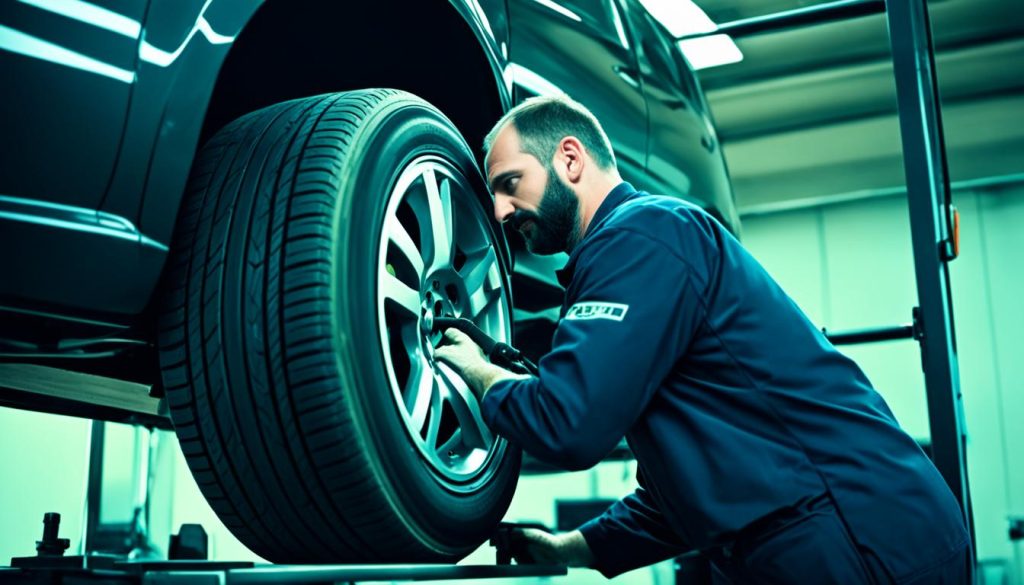
In conclusion, ensuring your car’s wheels are properly aligned after a collision is a crucial step in maintaining the vehicle’s performance, safety, and overall cost of ownership. By taking the time to address this important issue, you can enjoy a smooth, responsive driving experience while also protecting your investment in your vehicle.
What to Look for When Assessing Your Ride
After a car collision, it’s crucial to thoroughly inspect your vehicle to ensure its safety and roadworthiness. During this post-accident vehicle inspection, we’ll focus on key components that require close attention, such as the suspension, safety assessment, and overall alignment.
First and foremost, let’s examine the suspension components. These vital parts, including the shocks, struts, and springs, play a crucial role in maintaining your vehicle’s stability and handling. If any of these components have been compromised, it could significantly impact your car’s performance and pose a safety risk. Be sure to have a professional technician thoroughly inspect the suspension system.
Next, we’ll assess the overall safety of your vehicle. Check for any visible damage to the body, frame, or other critical structures. Look for signs of misalignment, such as uneven tire wear or a crooked steering wheel. If anything seems off, it’s best to have your car towed to a reputable repair facility for a comprehensive evaluation.
Lastly, let’s address the importance of wheel alignment. After a collision, it’s essential to ensure that your wheels are properly aligned. Misaligned wheels can lead to uneven tire wear, poor handling, and even increased fuel consumption. Be sure to have a professional technician perform a wheel alignment check as part of your post-accident vehicle inspection.
Remember, safety should always be the top priority when it comes to your vehicle. By thoroughly inspecting your car and addressing any issues, you can help ensure a smooth and safe driving experience in the days and weeks to come.
Steps to Check Alignment Post-Accident
After a collision, it’s crucial to inspect your vehicle’s alignment to ensure its safe and proper handling. Here are the steps you can take to check the alignment post-accident:
Keep an eye out for abnormal noises or responses
Pay close attention to any unusual sounds or responses from your car’s suspension, steering, and tires. Abnormal noises, such as squeaking or rubbing, or a car that pulls to one side may indicate an alignment issue.
Drive your car to the nearest alignment shop slowly
Carefully drive your vehicle to the nearest alignment inspection shop, maintaining a slow and cautious speed. Avoid sudden turns or maneuvers, as they could further exacerbate any existing alignment problems.
Ask the alignment shop to do a quick alignment check
Once at the alignment shop, request a thorough post-accident diagnosis and suspension and steering evaluation to determine the extent of the alignment issues. The experts can then perform the necessary adjustments to restore your car’s optimal handling and performance.
By following these steps, you can ensure that your vehicle’s alignment is properly inspected and corrected after an accident, helping to maintain its safety and longevity on the road.
The Signs That Your Wheel Alignment is Off
Detecting issues with your vehicle’s wheel alignment can be challenging, especially if you’re not a seasoned mechanic. However, there are several telltale signs that your wheels may be misaligned after a collision or accident. By keeping an eye out for these indicators, you can address the problem promptly and avoid further complications.
One of the most common signs of misaligned wheels is a vibration or jerking sensation while driving. This can be caused by uneven tire wear, which is a direct result of improper wheel alignment. Additionally, if your vehicle tends to pull to one side, it’s a strong indication that your alignment is off, compromising your steering and handling.
- Noisy or vibrating steering wheel: If your steering wheel feels unstable or produces unusual noises, it’s a sign that your wheels may be misaligned.
- Uneven tire tread wear: Closely inspect your tires for signs of uneven wear patterns, as this can be a telltale sign of alignment issues.
- Crooked steering wheel: If your steering wheel is not perfectly centered when driving straight, it could mean your wheels are not properly aligned.
- Tire noise: Listen for any unusual noises coming from your tires, as this can indicate that your wheels are not properly aligned.
If you notice any of these signs, it’s essential to have your vehicle’s alignment checked by a professional as soon as possible. Ignoring misaligned wheels can lead to further steering and handling issues and accelerated tire wear, ultimately compromising your safety and driving experience.
Wheel Alignment
Proper wheel alignment is crucial for maintaining your vehicle’s performance, handling, and safety on the road. Regular wheel alignment checks should be an integral part of your vehicle’s maintenance routine. Whether you have experienced a collision or simply want to ensure your car is running at its best, understanding the importance of wheel alignment is key.
Wheel alignment plays a vital role in the overall performance of your vehicle. When your wheels are not properly aligned, it can lead to uneven tire wear, reduced fuel efficiency, and compromised handling and stability. Neglecting wheel alignment can also increase the risk of future accidents, as your car may not respond as expected in critical driving situations.
- Regular wheel alignment checks help maintain your vehicle’s wheel alignment importance.
- Proper alignment ensures optimal vehicle performance and handling.
- Well-aligned wheels contribute to maintenance of your tires and fuel efficiency.

Whether you have experienced a collision or simply want to ensure your car is running at its best, regular wheel alignment checks should be a top priority. By keeping your wheels properly aligned, you can enjoy a smoother, more responsive ride and extend the lifespan of your tires and other critical components. Take the time to have your alignment checked and maintain your vehicle’s performance for many miles to come.
Conclusion
After a collision, ensuring your vehicle’s wheel alignment is properly checked and corrected is crucial for your safety and the longevity of your car. Proper wheel alignment helps reduce the chances of future accidents, improves handling and traction, and extends the life of your tires while enhancing fuel efficiency. At Miracle Body and Paint, we’re dedicated to providing comprehensive collision repair services, including thorough wheel alignment checks, to get your vehicle back on the road safely and efficiently.
If you’ve been in an accident, don’t hesitate to bring your car to our experts. We’ll thoroughly assess your wheel alignment and make any necessary adjustments to ensure your steering and suspension are in top working order. By taking the time to address wheel alignment issues, you can have peace of mind knowing your vehicle is operating at its best and you’re minimizing the risk of further damage or accidents.
Contact Miracle Body and Paint today to schedule an appointment and let us help you get your car back to its optimal performance and safety. We’re committed to providing the best collision repair services, including expert wheel alignment checks, to keep you and your loved ones safe on the road.


